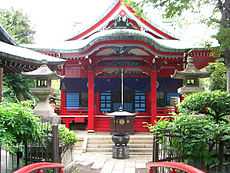Hinduism in Japan

Hinduism, unlike the closely related Buddhism, is a minority religion in Japan. Even so, Hinduism has played a somewhat significant role in Japanese culture.
History
There is a relatively small number of Hindus found throughout Japan. There are currently 4,000 registered Hindus in the country, with about one third located in the Kansai area and living in Kobe, where they remain the third largest foreign community, after Chinese and Koreans. The arrival of Hindus and other Indians in Japan began in the 1870s, when they arrived at Yokohama (specifically Osaka, center of the textile trade) and began a profitable business exporting textiles and silk yarn to India while importing cotton yarn to be manufactured in Japan, which eventually made textiles one of the largest and most cheaply produced exports. However, this rising Indian immigration ceased in the 1980s when competing cheap labor from third-world countries caused the textile industry to decline in Japan.
Cultural impact

Though Hinduism is a little-practiced religion in Japan, it has still had a significant, but indirect role in the formation of Japanese culture. This is mostly because many Buddhist beliefs and traditions (which share a common Dharmic root with Hinduism) spread to Japan from China via Korean peninsula in the 6th Century. One indication of this is the Japanese "Seven Gods of Fortune", of which three originated as Hindu deities, including Benzaiten (Sarasvati), Bishamon (Vaiśravaṇa or Kubera), and Daikoku (Shiva). Benzaiten arrived in Japan during the 6th through 8th centuries, mainly via the Chinese translations of the Sutra of Golden Light (金光明経), which has a section devoted to her. She is also mentioned in the Lotus Sutra. In Japan, the lokapālas take the Buddhist form of the Four Heavenly Kings (四天王). The Sutra of Golden Light became one of the most important sutras in Japan because of its fundamental message, which teaches that the Four Heavenly Kings protect the ruler who governs his country in the proper manner. The Hindu god of death, Yama, is known in his Buddhist form as Enma. Garuda, the mount (vahana) of Vishnu, is known as the Karura (迦楼羅), an enormous, fire-breathing creature in Japan. It has the body of a human and the face or beak of an eagle. Tennin originated from the apsaras. The Hindu Ganesha (see Kangiten) is displayed more than Buddha in a temple in Futako Tamagawa, Tokyo. Other examples of Hindu influence on Japan include the belief of "six schools" or "six doctrines" as well as use of Yoga and pagodas. Many of the facets of Hindu culture which have influenced Japan have also influenced Chinese culture.
People have written books on the worship of Hindu gods in Japan.[1] Even today, it is claimed Japan encourages a deeper study of Hindu gods.[2]
See also
- List of Hindu temples all over the world
- Religion in Japan
References
- ↑ Chaudhuri, Saroj Kumar. Hindu Gods and Goddesses in Japan. (New Delhi, 2003) ISBN 81-7936-009-1.
- ↑ "Japan wants to encourage studies of Hindu gods" Satyen Mohapatra
External links
- Hare Krishna temple in Japan
- Hindus in Japan
- Vedanta Society of Japan
- Ancient Japanese carving of Lord Krishna Playing a Flute, Nara, Japan
- A Tribute to Hinduism: India and China
- A Tribute to Hinduism: Suvarnabhumi, Greater India
- Hinduism in Japan
- The "Six Schools"
- Japan File: India
- Nippon Shakti
- Hindu Influence on Japan
- Japan's Hindu linkages still alive
| ||||||||||||||